Hi! It’s Anu again from the DuoThrivers team.
If you’ve been working on growing your Pinterest account, chances are you’ve come across Pinterest’s official tool – Pinterest Trends.
It’s one of the most powerful tools out there for Pinterest Keyword Research, and the best part? You can use it completely free.
But what exactly is Pinterest Trends? And how can you actually use it to find the right keywords that drive traffic and clicks?
That’s exactly what we’ll cover in this post.
If you’re ready, let’s dive right into the details!
What is Pinterest Trends Tool?
Well, the simple answer is – Pinterest Trends is one of the most powerful tools you can use for Keyword Research, Content Planning, and even launching Ad campaigns. And the best part? It’s completely free.
With this tool, you can not only see what’s trending right now, but also how a keyword has performed historically over the years.
This historical data is incredibly useful. It allows you to plan and create content ahead of time, long before the trend peaks, giving you a real advantage over others.
Pinterest took things even further by introducing a feature called “Predict the Future” for some keywords.
As the name suggests, this feature shows you a forecast of how a keyword might perform in the coming months, so you can prepare and stay ahead of the trend curve.
How to access the Pinterest Trends Tool?
You can access the Pinterest Trends Tool for free.
Here’s how to get started:
-
Log in to your Pinterest account and make sure it’s a Business Account.
-
On your PC, click on the menu icon (three horizontal lines) on the left side of the screen.
-
From the menu, select ‘Pinterest Trends’ under the Analyze performance section.
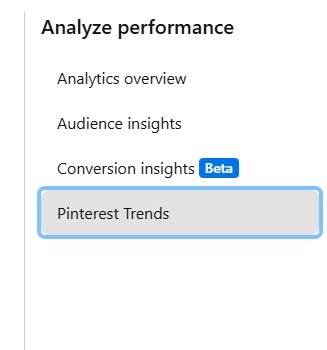
You can also visit the official Pinterest Trends link to access it directly. Just keep in mind—you’ll still need to log in to your business account to use it.
RECENTLY PUBLISHED: How to Become a Pinterest Creator to Earn $2000+
How to use Pinterest Trends Tool?
1. To Get Keyword Ideas
If you’re out of keyword ideas and need some inspiration, the Pinterest Trends Tool can be incredibly helpful.
Start by entering a popular keyword in your niche. Normally, you’d want to avoid generic terms, but for the sake of this example, let’s go with something broad like “outfit”.
If Pinterest has enough data for that keyword, it will immediately show you a list of related keywords that users are actively searching.
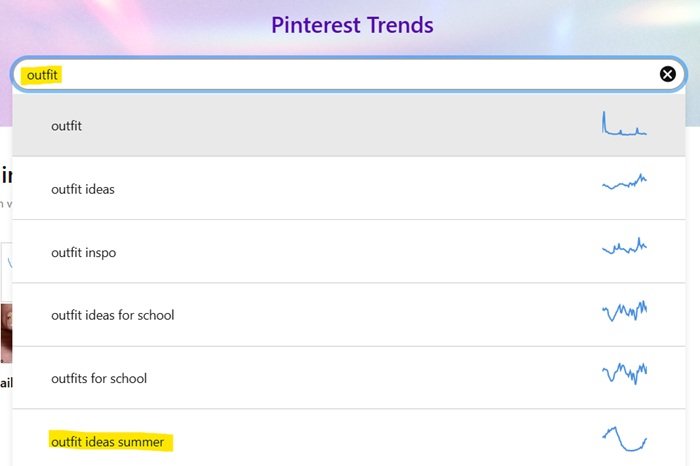
Let’s continue with the first related keyword we see – “Outfit ideas summer”. It looks like a high-potential keyword. You could create a board titled “Outfit Ideas for Summer” and build content around it.
Let’s select it to explore more.
When you click on that suggestion, Pinterest will show you another set of related keywords. Here, “Summer Outfits Aesthetic” stands out. This could be a great topic for a detailed blog post supported by eye-catching Pins.
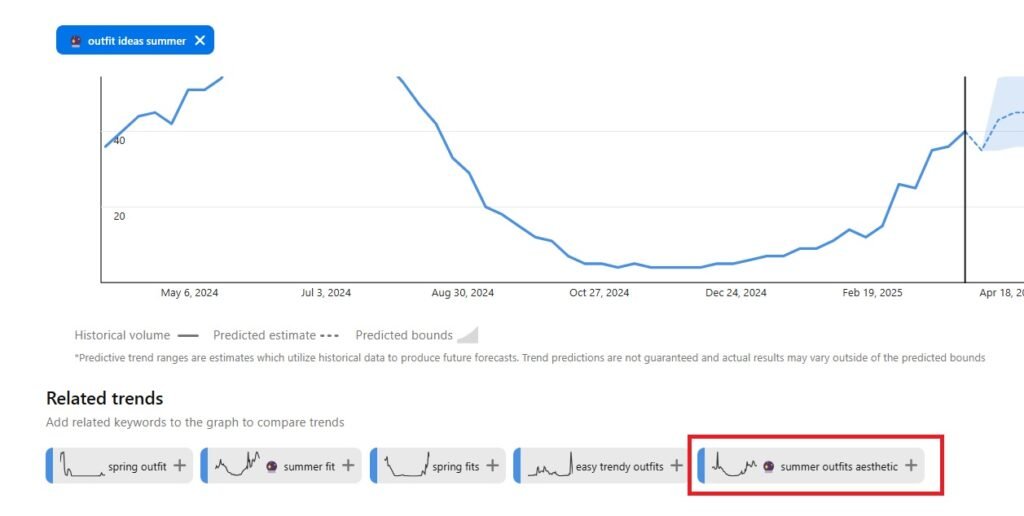
Clicking on “Summer Outfits Aesthetic” reveals two more suggestions:
“Beach Fits” and “Summer Style”.

Both are relevant, but since they are short-tail keywords, they likely come with higher competition.
If you’ve read our Pinterest Keyword Research Guide, you’ll remember that we always recommend targeting long-tail keywords for better chances of ranking and getting traffic.
Let’s continue the search by clicking on the “Beach Fits” tile.
And there it is—a long-tail keyword appears: “Beach vacay outfits”.
This is a much better option to target. It’s specific, highly relevant, and likely to have less competition.

You can continue digging deeper this way to find high-potential long-tail keywords for your niche.
Another effective method is to use the Pinterest Search Bar directly and explore the suggested search terms that appear as you type.
Next, we’ll explore how to check if a selected keyword actually has search volume. Pinterest doesn’t tell the exact search volume, but we have smart ways to find that out!
2. To Understand Keyword Feasibility
When you’re done creating a keyword pool using the methods we shared earlier, it’s time to check whether those keywords actually have the potential to bring in traffic.
To do that, we’ll take a closer look at the Pinterest Trends graph.
Now, the basic idea seems simple – if the graph shows an upward trend, that keyword must be good to use, right?
Well, not exactly. There’s a bit more to it!
Pinterest displays keyword performance on a Time vs. Interest graph, not a Time vs. Search Volume graph.
This means that the graph shows how popular a keyword is relative to its past performance, not the exact number of times it’s being searched. So while the trend can tell us if interest is increasing or decreasing, it won’t show exact search numbers.
Let’s understand this better with an example.
How does the performance for the keyword “Small Space Organization” look on the Trends graph?
Looks good, right?

Now, check the performance graph for these two keywords –
‘Small Space Organization’ & ‘Christmas Decor’.
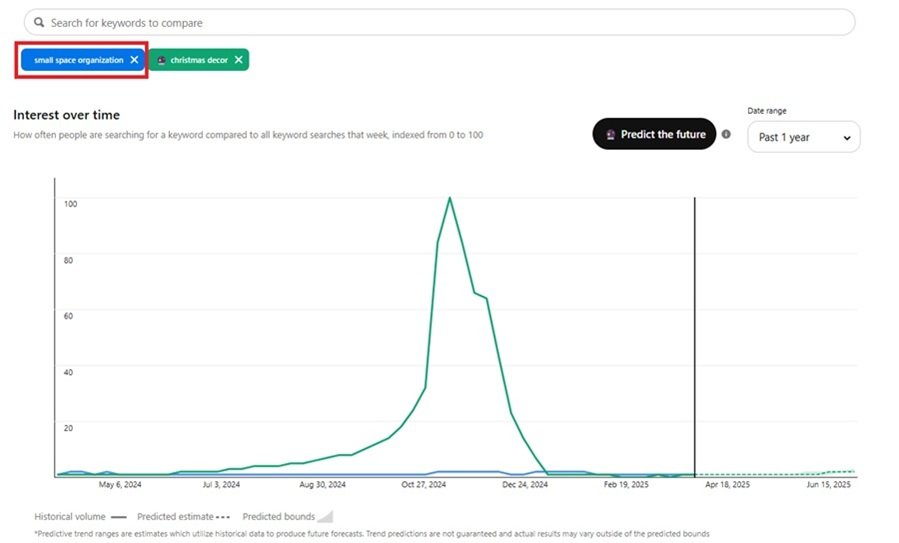
What about now? Does the keyword “Small Space Organization” still look good to you?
Well, your answer should be – Yes.
Here’s why: “Christmas Decor” is a short-tail, high-volume, seasonal keyword, and you’re comparing it with a long-tail, evergreen keyword like “Small Space Organization.” It’s not a fair comparison.
The fact that “Small Space Organization” doesn’t spike like “Christmas Decor” doesn’t mean it lacks potential. In fact, as a long-tail, non-seasonal keyword, it can offer steady traffic all year round.
To properly assess its true potential, you should compare it with other long-tail keywords from the same niche. That gives a much clearer picture of how it performs in context and whether it’s worth targeting.
Let’s see the comparison below –
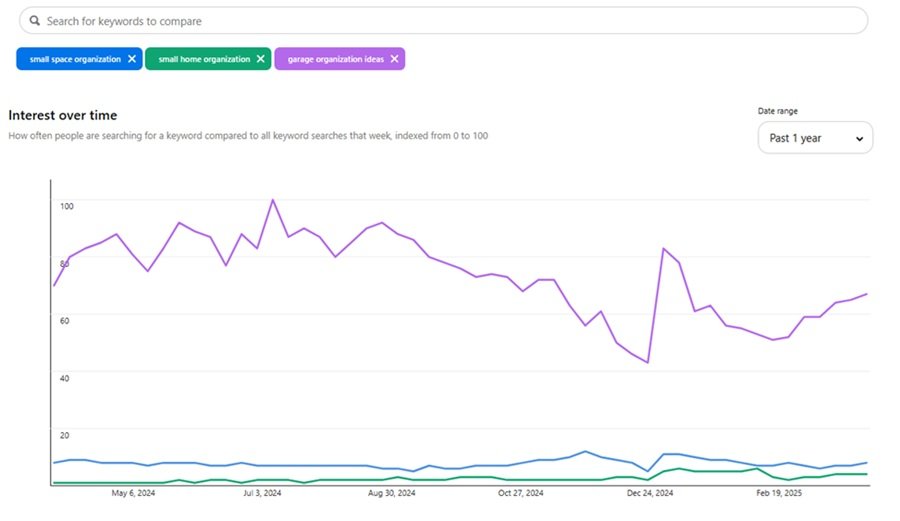
This performance graph simply means that “Small Space Organization” does have potential, but if too many sites are already covering the same topic, you shouldn’t expect a huge amount of traffic from it.
“Garage Organization Ideas”, on the other hand, shows better promise as a keyword worth targeting.
This approach helps you identify strong keywords and trends by making fair comparisons, instead of being misled by data that’s skewed due to mismatched keyword types or seasonal spikes.
🔍 Finding the exact search volume on Pinterest directly isn’t possible – it doesn’t show exact numbers like Google keyword planner.
That’s where tools like PinClicks come in. It helps you analyze real keyword trends, estimated volumes, and even discover untapped keywords you might’ve missed.
👉 You can get a 5 Days Free Trial – here, and use the code Thrivers25OFF to get 25% off your subscription.
3. To Plan Seasonal Content
If you’re planning to publish seasonal content this year, Pinterest Trends can be a powerful tool to help you build a solid publishing strategy.
Let me give you an example.
Suppose you’re working on an article around the keyword “Gluten Free Fall Desserts.”
By searching this keyword on Pinterest Trends, you’ll be able to see how interest in the topic changes over time.
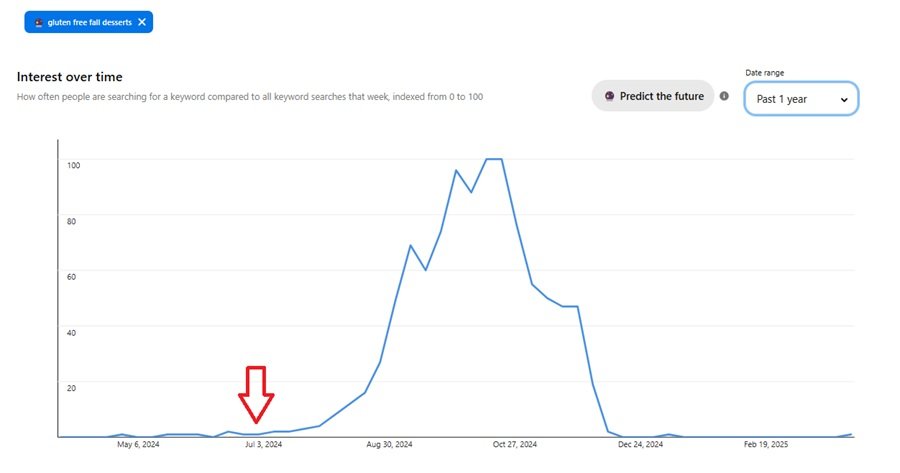
The interest for the keyword peaks in October, but people start showing interest in related content as early as July.
That means you should begin your Pin publishing cycle around July to catch the early momentum.
It also means your articles related to the topic need to be ready before that period, so you can start linking your Pins to them on time.
Pretty straightforward, right?
In the same way, you can plan ahead for any seasonal or trending keyword, and get a good share of the traffic by publishing content before the peak hits.
Just remember, if you start posting Pins a few months in advance, you should also keep publishing fresh ones consistently to stay relevant and boost your visibility.
And that’s all!
Pinterest Keyword Research is an important skill to have if you’re aiming for real growth on the platform. I’ve mentioned this again and again in my previous posts and for good reason.
A well-designed Pin can definitely drive traffic to your website, but it all starts with getting impressions, and that comes from doing strong keyword research.
Use tools like Pinterest Trends to understand what people are searching for and when. This helps you plan and publish content more strategically, giving your account a better chance to grow consistently.

